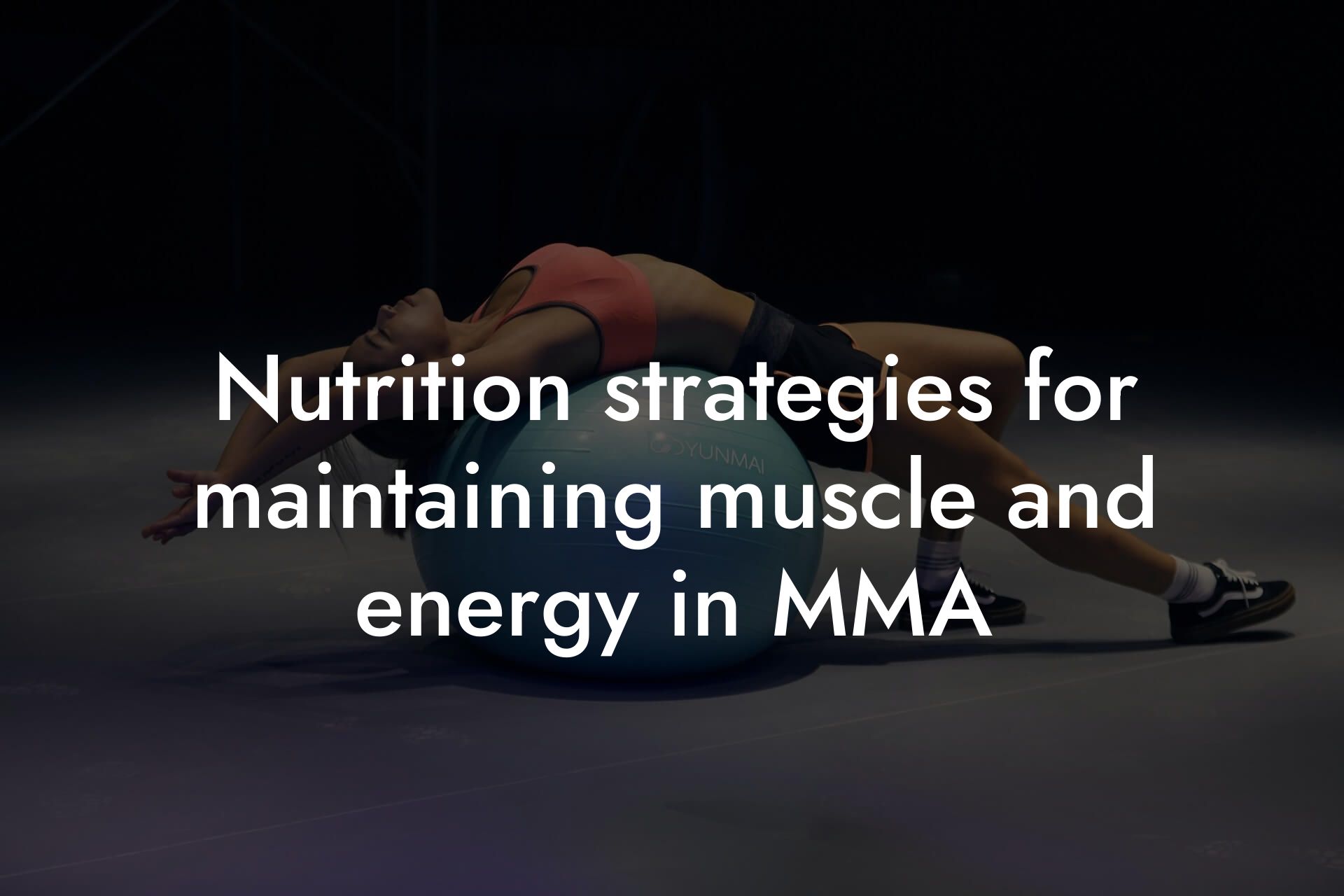As an MMA fighter, your off-season training and conditioning are crucial to your success in the octagon. It's during this time that you can focus on improving your weaknesses, building your strength and endurance, and perfecting your technique. In this article, we'll provide you with a comprehensive guide on how to make the most of your off-season training, including the importance of periodization, strength training, conditioning, nutrition, and recovery.
Table of Contents
Understanding Periodization
Periodization is a training methodology that involves dividing your training into specific periods or cycles, each with a specific goal or focus. In the context of MMA, periodization is essential to avoid plateaus and prevent overtraining. A typical periodized training plan for an MMA fighter might include a hypertrophy phase, a strength phase, a power phase, and a conditioning phase. Each phase should last around 4-6 weeks, with a deload week in between to allow for recovery.
Strength Training for MMA Fighters
Strength training is a critical component of an MMA fighter's off-season training. It helps improve your power, speed, and endurance, all of which are essential for success in the octagon. A well-structured strength training program should include exercises that target your entire body, including your upper body, lower body, and core. Some exercises that are particularly beneficial for MMA fighters include squats, deadlifts, bench press, rows, and lunges.
When designing your strength training program, it's essential to consider your specific goals and needs. For example, if you're a grappler, you may want to focus on exercises that improve your pulling strength, such as rows and lat pulldowns. If you're a striker, you may want to focus on exercises that improve your punching power, such as medicine ball throws and plyometric exercises.
Conditioning for MMA Fighters
Conditioning is another critical component of an MMA fighter's off-season training. It helps improve your endurance, agility, and speed, all of which are essential for success in the octagon. A well-structured conditioning program should include a combination of aerobic and anaerobic exercises, such as running, jumping rope, and bag work.
One of the most effective conditioning exercises for MMA fighters is high-intensity interval training (HIIT). HIIT involves short bursts of high-intensity exercise followed by brief periods of rest. This type of training is particularly effective for improving your anaerobic endurance, which is essential for MMA fighting.
Nutrition for MMA Fighters
Nutrition plays a critical role in an MMA fighter's off-season training. A well-structured nutrition plan should provide you with the energy you need to power through your training, while also supporting your recovery and muscle growth. Some of the key nutrients that are essential for MMA fighters include protein, complex carbohydrates, and healthy fats.
When designing your nutrition plan, it's essential to consider your specific goals and needs. For example, if you're trying to lose weight, you may want to focus on a low-carb, high-protein diet. If you're trying to gain muscle, you may want to focus on a high-calorie, high-protein diet.
Recovery Strategies for MMA Fighters
Recovery is a critical component of an MMA fighter's off-season training. It helps your body repair and adapt to the demands of training, which is essential for making progress and avoiding injury. Some of the most effective recovery strategies for MMA fighters include foam rolling, stretching, and self-myofascial release.
Another effective recovery strategy is active recovery, which involves engaging in low-intensity aerobic exercise, such as cycling or swimming, to promote blood flow and reduce muscle soreness. Additionally, getting enough sleep and managing your stress levels are also critical for recovery.
Body Composition Analysis for MMA Fighters
As an MMA fighter, your body composition is critical to your success in the octagon. A high percentage of body fat can negatively impact your performance, while a low percentage of body fat can improve your speed, agility, and endurance. At Tano Performance Group, we use DEXA scans to provide MMA fighters with a comprehensive body composition analysis, including their percentage of body fat, lean muscle mass, and bone density.
Our DEXA scans are highly accurate and provide a detailed breakdown of your body composition, which can help you identify areas for improvement and track your progress over time. By using our DEXA scans, you can optimize your training and nutrition plan to achieve your goals and take your performance to the next level.
Creating a Periodized Training Plan
Creating a periodized training plan is essential for MMA fighters who want to optimize their off-season training. A well-structured training plan should include a combination of strength training, conditioning, and technical training, with a specific focus and goal for each phase.
When creating your training plan, it's essential to consider your specific goals and needs, as well as your current fitness level and training experience. You should also include regular assessments and evaluations to track your progress and make adjustments to your plan as needed.
In conclusion, off-season training and conditioning are critical components of an MMA fighter's success in the octagon. By incorporating periodization, strength training, conditioning, nutrition, and recovery into your training program, you can optimize your performance and achieve your goals. Additionally, using DEXA scans to track your body composition can help you identify areas for improvement and make data-driven decisions about your training and nutrition plan.
At Tano Performance Group, we're committed to helping MMA fighters like you achieve their goals and take their performance to the next level. Our team of experts can provide you with personalized coaching, training, and nutrition plans, as well as comprehensive body composition analysis using our state-of-the-art DEXA scans. Contact us today to learn more about how we can help you achieve your goals and become a champion MMA fighter.
Frequently Asked Questions
What is off-season training and conditioning for MMA fighters?
Off-season training and conditioning for MMA fighters refers to the period of time when a fighter is not actively competing in a fight or tournament. During this time, they focus on improving their overall fitness, strength, and technique to prepare for their next competition.
Why is off-season training important for MMA fighters?
Off-season training is crucial for MMA fighters as it allows them to work on their weaknesses, improve their strengths, and recover from any injuries or fatigue accumulated during the competition season. This period of training helps fighters to peak at the right time and perform at their best when it matters most.
How long should an MMA fighter's off-season training last?
The duration of an MMA fighter's off-season training can vary depending on their individual needs and goals. Typically, it can last anywhere from 8-16 weeks, but it's not uncommon for some fighters to take a longer break to focus on recovery and rebuilding.
What are the key components of an effective off-season training program for MMA fighters?
A well-rounded off-season training program for MMA fighters should include a combination of strength training, conditioning, technical skill development, and active recovery. This helps to improve overall fitness, increase strength and power, and enhance technical skills such as striking, grappling, and wrestling.
How can MMA fighters incorporate strength training into their off-season program?
MMA fighters can incorporate strength training into their off-season program by focusing on exercises that improve their overall strength, power, and endurance. This can include weightlifting, resistance band training, and bodyweight exercises that target specific muscle groups such as the legs, core, and upper body.
What are some effective conditioning exercises for MMA fighters during the off-season?
Effective conditioning exercises for MMA fighters during the off-season include high-intensity interval training (HIIT), pro agility shuttles, battle ropes, and strength endurance exercises such as burpees and jump squats. These exercises help to improve cardiovascular fitness, increase speed and agility, and enhance muscular endurance.
How can MMA fighters improve their technical skills during the off-season?
MMA fighters can improve their technical skills during the off-season by working with their coaches and training partners to identify areas for improvement. They can also focus on specific drills and exercises that target weaknesses in their technique, such as striking combinations, takedown defense, and submission escapes.
What is active recovery and how can MMA fighters incorporate it into their off-season program?
Active recovery refers to low-intensity exercises and activities that help to promote recovery and reduce muscle soreness. MMA fighters can incorporate active recovery into their off-season program by including activities such as yoga, stretching, foam rolling, and light cardio exercises like jogging or cycling.
How can MMA fighters balance their off-season training with rest and recovery?
MMA fighters can balance their off-season training with rest and recovery by listening to their bodies and taking regular breaks to avoid burnout and injury. They should also prioritize sleep, nutrition, and stress management to ensure they're recovering adequately between training sessions.
What are some common mistakes MMA fighters make during the off-season?
Common mistakes MMA fighters make during the off-season include overtraining, neglecting rest and recovery, and failing to address weaknesses in their technique. They may also focus too much on conditioning and neglect strength training, or vice versa.
How can MMA fighters stay motivated during the off-season?
MMA fighters can stay motivated during the off-season by setting specific goals and milestones, working with a training partner or coach, and tracking their progress through metrics such as weight, body fat percentage, and performance data.
Can MMA fighters still compete in smaller tournaments or exhibitions during the off-season?
Yes, MMA fighters can still compete in smaller tournaments or exhibitions during the off-season, but they should be careful not to overexert themselves and risk injury. These types of competitions can help to maintain their competitive edge and provide valuable experience.
How can MMA fighters incorporate mental preparation into their off-season training?
MMA fighters can incorporate mental preparation into their off-season training by working on visualization techniques, mindfulness exercises, and positive self-talk. They can also work with a sports psychologist to develop strategies for managing competition anxiety and staying focused under pressure.
What role does nutrition play in an MMA fighter's off-season training?
Nutrition plays a critical role in an MMA fighter's off-season training, as it helps to support muscle growth and recovery. Fighters should focus on consuming a balanced diet that includes plenty of protein, complex carbohydrates, and healthy fats, and avoid excessive sugar and processed foods.
How can MMA fighters use technology to enhance their off-season training?
MMA fighters can use technology to enhance their off-season training by tracking their progress through wearable devices and mobile apps, analyzing their performance data to identify areas for improvement, and using virtual reality training tools to simulate fight scenarios.
What are some common injuries MMA fighters experience during the off-season?
Common injuries MMA fighters experience during the off-season include overuse injuries such as tendonitis and stress fractures, as well as acute injuries such as concussions and ligament sprains. Fighters should take proactive steps to prevent injuries by incorporating injury prevention exercises and stretching into their training program.
How can MMA fighters modify their off-season training program if they're injured?
If an MMA fighter is injured during the off-season, they can modify their training program to focus on rehabilitation and recovery. This may involve working with a physical therapist or athletic trainer to develop a customized rehabilitation program, and incorporating low-impact exercises and activities to maintain cardiovascular fitness.
What are some benefits of working with a coach or training partner during the off-season?
Working with a coach or training partner during the off-season can provide MMA fighters with accountability, motivation, and technical guidance. It can also help to identify areas for improvement and provide support and encouragement during the training process.
How can MMA fighters stay hydrated during the off-season?
MMA fighters can stay hydrated during the off-season by drinking plenty of water throughout the day, avoiding sugary drinks and caffeine, and incorporating electrolyte-rich foods and supplements into their diet.
What are some common myths about off-season training for MMA fighters?
Common myths about off-season training for MMA fighters include the idea that they should take a complete break from training, or that they should focus solely on conditioning and neglect strength training. These myths can lead to a decrease in performance and increase the risk of injury.
How can MMA fighters incorporate flexibility and mobility exercises into their off-season program?
MMA fighters can incorporate flexibility and mobility exercises into their off-season program by including activities such as yoga, stretching, and foam rolling. These exercises can help to improve range of motion, reduce muscle soreness, and enhance overall athletic performance.
What are some key performance indicators (KPIs) MMA fighters should track during the off-season?
Key performance indicators (KPIs) MMA fighters should track during the off-season include metrics such as weight, body fat percentage, strength, power, speed, agility, and endurance. These metrics can help fighters to track their progress and identify areas for improvement.
Here are some related articles you might love...
- Reducing body fat for optimal weight class in MMA
- Nutrition strategies for maintaining muscle and energy in MMA
- Strength and conditioning programs for MMA fighters
- The role of DEXA scans in MMA training and weight management
- The importance of lean muscle mass in MMA performance
- Recovery techniques for MMA athletes after fights
- How body composition affects performance in MMA
- Balancing power, speed, and agility in MMA training
- Bone density and injury prevention in MMA
Zak Faulkner
Zak Faulkner is a leading authority in the realm of physical health and body composition analysis, with over 15 years of experience helping professionals optimise their fitness and well-being. As one the experts behind Tano Performance Group, Zak has dedicated his career to providing in-depth, science-backed insights that empower clients to elevate their physical performance and overall health.
With extensive knowledge of DEXA technology, Zak specializes in delivering comprehensive body assessments that offer precise data on body fat, muscle mass, bone density, and overall physique. His expertise enables individuals to make informed decisions and achieve their fitness goals with accuracy and confidence. Zak’s approach is rooted in a deep understanding of human physiology, combined with a passion for helping clients unlock their full potential through personalised strategies.
Over the years, Zak has earned a reputation for his commitment to excellence, precision, and client-focused service. His guidance is trusted by top professionals who demand the best when it comes to their health. Whether advising on fitness programs, nutritional strategies, or long-term wellness plans, Zak Faulkner’s insights are a valuable resource for anyone serious about taking their health and fitness to the next level.
At Tano Performance Group, Zak continues to lead our Content Team revolutionising how professionals approach their physical health, offering unparalleled expertise that drives real results.




